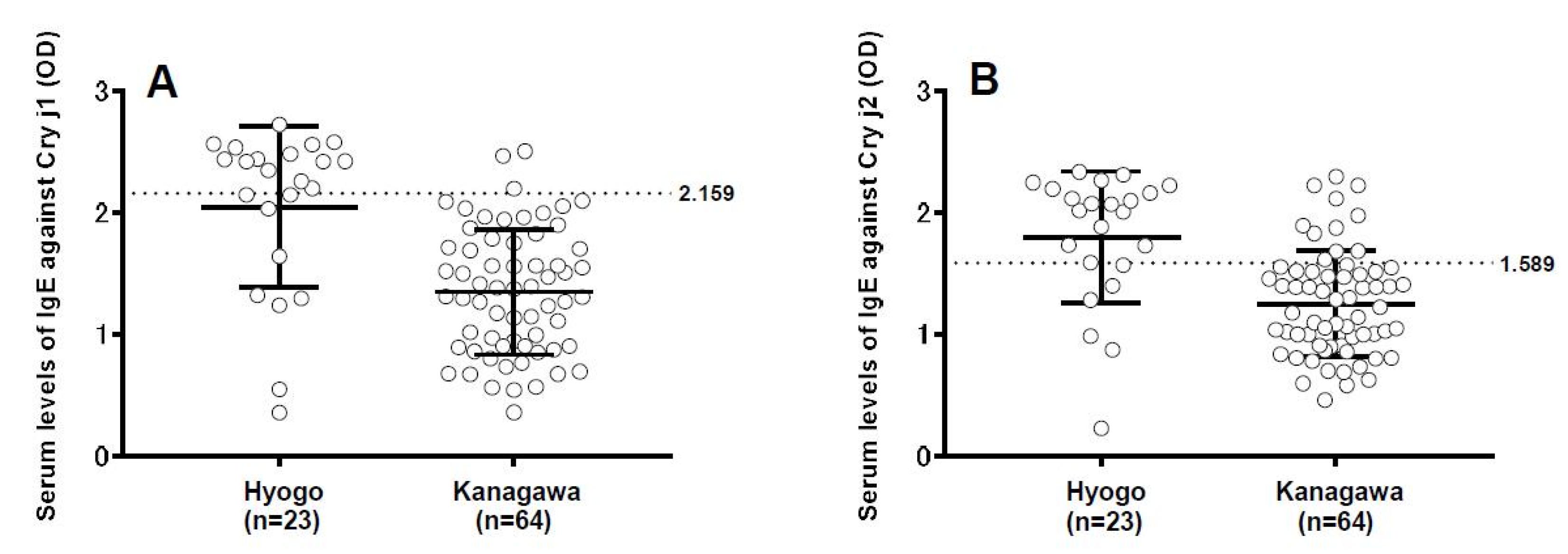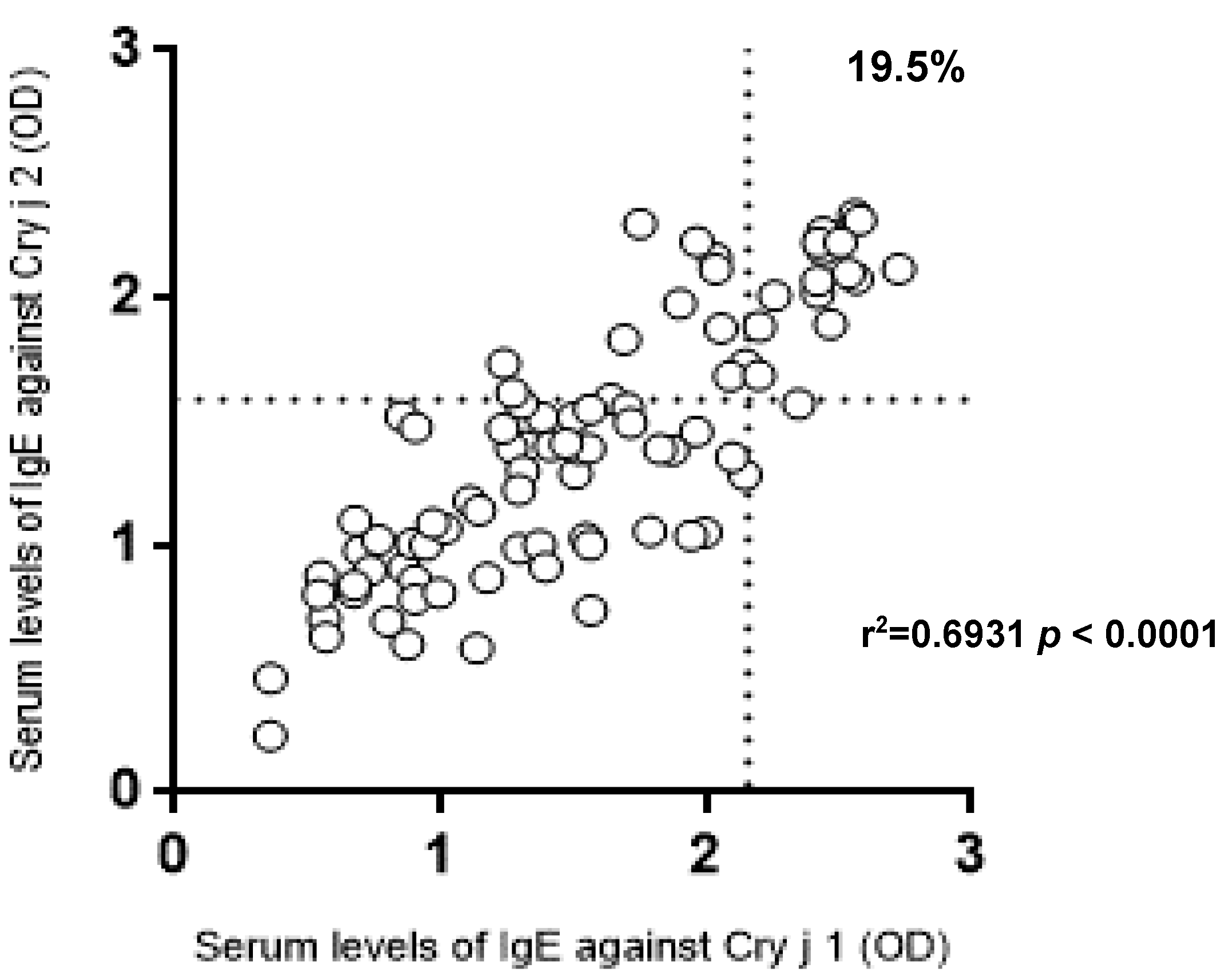Seroprevalence of Immunoglobulin E Antibodies against Japanese Cedar Pollen Allergens Cry j 1 and Cry j 2 in Dogs Bred in Japan
Abstract
:1. Introduction
2. Materials and Methods
2.1. Sera
2.2. Enzyme-Linked Immunosorbent Assay
2.3. Statistics
3. Results
4. Discussion
5. Conclusions
Author Contributions
Funding
Acknowledgments
Conflicts of Interest
References
- Ogasawara, H.; Yoshimura, S.; Goto, M.; Tuyu, M.; Fujitani, T.; Nakahara, S. The increase of the total counts of Sugi (Cryptomeria japonica) due to the increasing area of mature Sugi forests. Jpn. J. Palynol. 1998, 44, 97–105, (In Japanese with English Abstract). [Google Scholar]
- Murayama, M. Year variation of pollen counts and pollen forecast. Igaku No Ayumi 2002, 200, 417–421. (In Japanese) [Google Scholar]
- Sato, K.; Nakazawa, T.; Sahashi, Y.; Kochibe, N. Yearly and seasonal changes of specific IgE to Japanese cedar pollen in young population. Ann. Allergy Asthma Immunol. 1997, 79, 57–61. [Google Scholar] [CrossRef]
- Harima-Mizusawa, N.; Iino, T.; Onodera-Masuoka, N.; Kato-Nagaoka, N.; Kishima-Shibata, J.; Gomi, A.; Shibahara-Sone, H.; Kano, M.; Shida, K.; Sakai, M.; et al. Benefical effects of citrus juice fermented with Lactobacillus plantarum YIT 0132 on Japanese cedar pollinosis. Biosci. Microbiota Food Health 2014, 33, 147–155. [Google Scholar] [CrossRef] [PubMed]
- Saito, Y. Japanese cedar pollinosis: Discovery, nomenclature, and epidemiological trends. Proc. Jpn. Acad. Ser. B Phys. Biol. Sci. 2014, 90, 203–209. [Google Scholar] [CrossRef] [PubMed]
- Teranishi, H.; Saito, M. Discovery of a male-sterile variety of Japanese cedar (Cryptomeria japonica) and application for reduction of related pollinosis. Jpn. J. Palynol. 2017, 62, 87–92, (In Japanese with English Abstract). [Google Scholar]
- Inoue, S.; Sakaguchi, M.; Hori, M.; Watanabe, T. A seroepidemiological study of Cryptomeria japonica (Japanese ceder) pollinosis: Measurement of IgE antibody. Igaku No Ayumi 1986, 36, 959–960. (In Japanese) [Google Scholar]
- Takaishi, M.; Aoyagi, T.; Masuda, T.; Chiba, M. Pollen allergy due to Japanese cedar pollen and preventive measures by Tochigi Prefecture Government. J. Int. Univ. Health Welf. 2014, 19, 7–17, (In Japanese with English Abstract). [Google Scholar]
- Sasaki, Y.; Kitagawa, H.; Fujioka, T.; Kitoh, K.; Iwasaki, T.; Sakaguchi, M.; Inouye, S. Hypersensitivity to Japanese cedar (Cryptomeria japonica) pollen in dogs. J. Vet. Med. Sci. 1995, 57, 683–685. [Google Scholar] [CrossRef] [PubMed]
- Masuda, K. DNA vaccination against Japanese cedar pollinosis in dogs suppress type I hypersensitivity by controlling lesional mast cells. Vet. Immunol. Immunopathol. 2005, 108, 185–187. [Google Scholar] [CrossRef] [PubMed]
- Mueller, R.S.; Janda, J.; Jarolim, E.J.; Rhyner, C.; Marti, E. Allegens in veterinary medicine. Allergy 2016, 71, 27–35. [Google Scholar] [CrossRef] [PubMed]
- Masuda, K.; Sakaguchi, M.; Fujiwara, S.; Kurata, K.; Yamashita, K.; Odagiri, T.; Nakao, Y.; Matsuki, N.; Ono, K.; Watarai, T.; et al. Positive reactions to common allergens in 42 atopic dogs in Japan. Vet. Immunol. Immunopathol. 2000, 73, 193–204. [Google Scholar] [CrossRef]
- Yamashita, K.; Masuda, K.; Sakaguchi, M.; Odagiri, T.; Nakano, Y.; Yamaki, M.; Hasegawa, A.; Matsudo, Y.; Deboer, D.J.; Ohno, K.; et al. Experimental sensitization with Japanese cedar pollen in dogs. J. Vet. Med. Sci. 2000, 62, 1223–1225. [Google Scholar] [CrossRef] [PubMed]
- Yasueda, H.; Yui, Y.; Shimazu, T.; Shida, T. Isolation and partial characterization of the major allergen from Japanese ceder (Cryptomeria Japonica) pollen. J. Allergy Clin. Immunol. 1983, 71, 77–86. [Google Scholar] [CrossRef]
- Matsuda, K.; Tsujimoto, H.; Fujiwara, S.; Kurata, K.; Hasegawa, A.; Taniguchi, Y.; Yamashita, K.; Yasueda, H.; Deboer, D.J.; de Weck, A.L.; et al. IgE-reactivity pollen allergens (Cry j 1 and Cry j 2) by ELISA in dogs with atopic dermatitis. Vet. Immunol. Immunopathol. 2000, 74, 263–270. [Google Scholar] [CrossRef]
- Picture of Japanese Map. Available online: http://www.freeformat.co.jp/Image/Map/JPN01_R.jpg (accessed on 8 July 2018).
- Enomoto, T.; Onishi, S.; Sogo, H.; Dake, Y.; Ikdea, H.; Funakoshi, H.; Shibano, A.; Sakoda, T. Japanese cedar pollen in floating indoor house dust after a pollinating season. Allergol. Int. 2004, 53, 279–285. [Google Scholar] [CrossRef]
- Ohashi, E.; Yoshida, Y.; Ooka, R.; Miyazawa, H. Indoor concentration of airborne cedar pollen and allergen (Cry j 1). Indoor air-pollution by Japanese cedar pollen. J. Environ. Eng. AIJ 2005, 70, 39–43, (In Japanese with English Abstract). [Google Scholar] [CrossRef]
- Ohashi, E.; Yoshida, S.; Ooka, R.; Miyazawa, H. Indoor pollution levels intrusion rate of Japanese cedar pollen and the Cry j 1 levels of a single cedar pollen practice. J. Environ. Eng. AIJ 2010, 75, 205–211, (In Japanese with English Abstract). [Google Scholar] [CrossRef]
- Takikawa, Y.; Matsuda, Y.; Nonomura, T.; Kakutani, K.; Kusakari, S.; Toyoda, H. An electrostatic-barrier-forming window that captures airborne pollen grains to prevent pollinosis. Int. J. Environ. Res. Public Health 2017, 14, 82. [Google Scholar] [CrossRef] [PubMed]
- Kiyosawa, H.; Nozaki, A.; Yoshizawa, S. Studies on performance of domestic air cleaners indoor air pollutants and prediction of indoor concentrations. J. Environ. Eng. AIJ 2004, 576, 37–42, (In Japanese with English Abstract). [Google Scholar]
- Inoue, S.; Sakaguchi, M.; Morita, M.; Shoji, T.; Kaneda, S.; Kimura, E.; Yamamoto, Y.; Inoue, H.; Ono, T.; Doke, S.; et al. Regional difference in the prevalence of IgE antibody to Japanese ceder pollen. Igaku No Ayumi 1998, 145, 121–122, (In Japanese with English Abstract). [Google Scholar]
- Lian, T.M.; Halliwell, R.E. Allergen-specific IgE and IgG antibodies in atopic and normal dogs. Vet. Immunol. Immunopathol. 1998, 66, 203–223. [Google Scholar] [CrossRef]
- Hashimoto, M.; Nigi, H.; Sakaguchi, M.; Inouye, S.; Imaoka, K.; Miyazawa, H.; Taniguchi, Y.; Kurimoto, M.; Yasueda, H.; Ogawa, T. Sensitivity to two major allergens (Cry j 1 and Cry j 2) in patients with Japanese cedar (Cryptomeria japonica) pollinosis. Clin. Exp. Allergy 1995, 25, 848–852. [Google Scholar] [CrossRef] [PubMed]
- Sakaguchi, M.; Inoue, S.; Taniai, M.; Ando, S.; Usui, M.; Matsuhashi, T. Identification of the second major allergen of Japanese ceder pollen. Allergy 1990, 45, 309–312. [Google Scholar] [CrossRef] [PubMed]
- Kondo, Y.; Ipsen, H.; Lowenstein, H.; Karpas, A.; Hsieh, L.S. Comparison of concentrations of Cry j 1 and Cry j 2 in diploid and triploid Japanese cedar (Cryptomeria japonica) pollen extracts. Allergy 1997, 52, 455–459. [Google Scholar] [CrossRef] [PubMed]
- Osada, T. Novel information regarding the allergens of Japanese cypress pollen. J. Jpn. Soc. Immunol. Allergol. Otolaryngol. 2018, 36, 23–28, (In Japanese with English Abstract). [Google Scholar] [CrossRef]




© 2018 by the authors. Licensee MDPI, Basel, Switzerland. This article is an open access article distributed under the terms and conditions of the Creative Commons Attribution (CC BY) license (http://creativecommons.org/licenses/by/4.0/).
Share and Cite
Kuribayashi, T.; Cossu, D.; Momotani, E. Seroprevalence of Immunoglobulin E Antibodies against Japanese Cedar Pollen Allergens Cry j 1 and Cry j 2 in Dogs Bred in Japan. Vet. Sci. 2018, 5, 79. https://doi.org/10.3390/vetsci5030079
Kuribayashi T, Cossu D, Momotani E. Seroprevalence of Immunoglobulin E Antibodies against Japanese Cedar Pollen Allergens Cry j 1 and Cry j 2 in Dogs Bred in Japan. Veterinary Sciences. 2018; 5(3):79. https://doi.org/10.3390/vetsci5030079
Chicago/Turabian StyleKuribayashi, Takashi, Davide Cossu, and Eiichi Momotani. 2018. "Seroprevalence of Immunoglobulin E Antibodies against Japanese Cedar Pollen Allergens Cry j 1 and Cry j 2 in Dogs Bred in Japan" Veterinary Sciences 5, no. 3: 79. https://doi.org/10.3390/vetsci5030079
APA StyleKuribayashi, T., Cossu, D., & Momotani, E. (2018). Seroprevalence of Immunoglobulin E Antibodies against Japanese Cedar Pollen Allergens Cry j 1 and Cry j 2 in Dogs Bred in Japan. Veterinary Sciences, 5(3), 79. https://doi.org/10.3390/vetsci5030079





